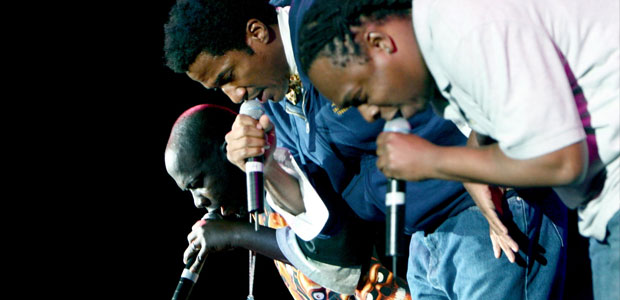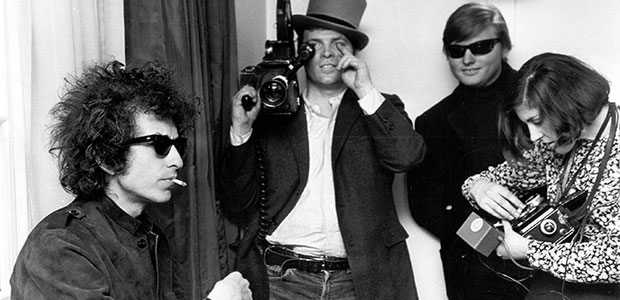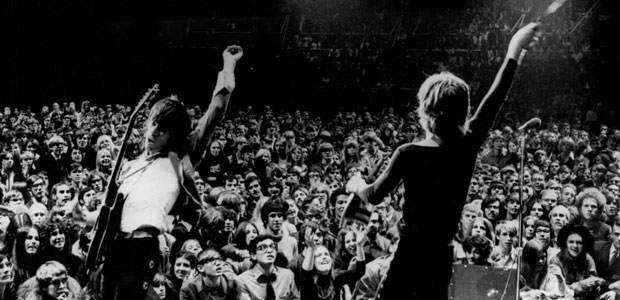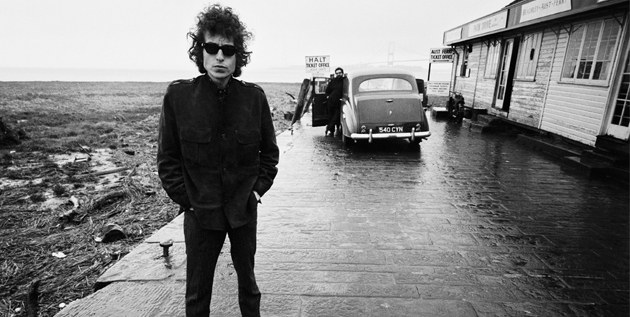While one can endlessly listen to the great albums of their favorite bands, there is something special when a documentary can effectively expand on a certain musical talent. Hollywood often provides regular reminders of how not to approach such a project, with by-the-numbers concert documentaries attempting to cash in on the latest pop sensation (although, we’ll admit that Jon Chu‘s 3-D Justin Bieber doc Never Say Never was better than it had any right to be), but every so often filmmakers can get it right.
The music documentary can also take many forms, with the inherent success story in capturing the rise (and possible fall) of a popular act often providing some of the best stories the medium has to offer. Then there are simply wonderfully constructed documentaries of performance, as well as many that provide a mix of both. In honor of this week’s recommended documentary on one of music’s most popular bands, Don’t Stop Believin’: Everyman’s Journey, we’ve rounded up 20 great examples across a wide variety of styles and genres. Check out our rundown below and let us know your favorites in the comments.
Anvil! The Story of Anvil (Sacha Gervasi, 2008)

Sacha Gervasi‘s Anvil! The Story of Anvil is an interesting triumph, providing proof you should keep fighting because one day, although you may not find success in North America, you’ll be big in Japan. Anvil is the story of a band that played with some of rock’s most successful acts only to be the one that somehow did not connect. Living under the radar in the Greater Toronto Area, they never gave up the dream, touring and releasing an album independently. Gervasi’s must-see documentary is an inspirational look at the fight for success and one that has helped the band find a new audience. – John F.
Beats Rhymes & Life: The Travels of a Tribe Called Quest (Michael Rapaport, 2011)

Putting to film the story of one the oldest, most prominent hip-hop groups around was no easy task, but after a few years in production actor/director Michael Rapaport finally premiered Beats Rhymes & Life: The Travels of a Tribe Called Quest at Sundance 2011, where it was met with deserved praise. Chronicling the rise and break-up of the group, Rapaport carefully balances genuine struggle with impressive performances, reminding us why we fell in love with these artists in the first place. – Jordan R.
Dave Chappelle’s Block Party (Michel Gondry, 2005)

This one is pure joy for anyone who likes hip hop, New York, Dave Chappelle, block parties or just music, even just a little bit. With energy so positive and infectious, it’s impossible not to smile throughout. Shortly after his dramatic exit from his mega-hit sketch show Chappelle’s Show, the comedian hosted a free block party in the Bedford-Stuyvesant neighborhood in Brooklyn. Among those invited to perform were some of hip-hop’s most iconic acts, including Common, Mos Def, Talib Kweli, The Roots, Erykah Badu, Jill Scott, Dead Prez, Kanye West and the Fugees — yes, even the Fugees reunited (briefly) for this event. If this movie is good enough for that act to occur, it’s plenty good enough for you to rock out to. – Tim C.
The Devil and Daniel Johnston (Jeff Feuerzeig, 2005)

A somber and intimate portrait of the titular Austin spoken word and folk artist, Jeff Feuerzeig‘s music documentary The Devil and Daniel Johnson is about the pain and alienation contained within Johnston’s work and life. He’s a talent who was ever appreciated by his fundamentalist Christian family, becoming another figure embracing the “keep Austin weird” ethos. The film is haunting and beautiful, a portrait of an artist who speaks genuine truth with his DIY aesthetic. – John F.
Dont Look Back and No Direction Home (D.A. Pennebaker, 1967; Martin Scorsese, 2005)

How appropriate that two portraits of Bob Dylan, both placed at similar junctures in his life, would feel like chronicles of separate geniuses. D.A. Pennebaker‘s behind-the-scenes tale showed the generational icon to be something of an intolerable prick, while Martin Scorsese‘s epic account, given the advantage of passing decades, re-contextualizes this to depict a man unable of figuring out who he’s even supposed to be. These two pictures are not exactly different sides of the same coin; taking the incalculable weight and depth of Dylan’s legacy into account, they’re more akin to drops in an ocean of consideration. But what drops they are. – Nick N.
The Fearless Freaks (Bradley Beesley, 2005)

It may be blasphemous around these parts, but as someone who wouldn’t count themselves as a fan of the Oklahoma-based rock band The Flaming Lips, the inclusion of this documentary is truly a testament to its quality. While Bradley Beesley does highlight their musical talent, the main focus here is the band’s development and personal insight into each of its respective members, including a harrowing scene depicting Steven Drozd‘s battle with drugs. Even, and perhaps especially, if you are a newcomer to their music, this is a must-watch. – Jordan R.
George Harrison: Living in the Material World (Martin Scorsese, 20111)

Scorsese‘s second comprehensive dive into a supreme musical artist’s world is an altogether different beast. Tinged in equal measure with reverence and sadness, he asks viewers to process a life and legacy in unusual, demanding ways, suggesting entire worlds of thought in the juxtaposition of a particular song and image, even jettisoning some (typically) talking head-provided information with the careful placement of clips, thus opening new avenues for the attentive viewer. There are times when its strange sense of internal direction makes Living in the Material World feel closer to a living, breathing organism than a documentary; it’s a ploy which comes to evoke the consistency of its own subject, for whom this project, in turn, becomes as good a cinematic tribute as could be demanded. However, if someone only wants a comprehensive and entertaining window into an ex-Beatle‘s life, they can have at it, too. – Nick N.
Gimme Shelter (Albert & David Maysles and Charlotte Zwerin, 1970)

Perhaps the finest documentary on this entire list, the Maysles were more than just in the right place at the right time for this Rolling Stones documentary. Taking what they learned on masterpieces like Salesman, this group was on the forefront of the Direct Cinema movement and here they captured the iconic, horrific Altamont stabbing with staggering authenticity — a definitive turning point of the era. Coupled in with an inside, intimate look at the highs and the lows of one of the most popular bands on the planet, this is vital viewing for anyone interested in the medium. – Jordan R.
Heima (Dean DeBlois, 2007)

2007 was easily one of the best years in recent cinema, but when most film lovers rattle off their favorites (from No Country For Old Men to There Will be Blood to The Assassination of Jesse James), this stunning documentary rarely gets mentioned. From Dean DeBlois (who would go on to give us the delightful How To Train Your Dragon), this concert film follows Iceland’s Sigur Rós on tour, complete with jaw-dropping cinematography, a perfect match for the heavenly music that accompanies the visuals. Consider this my plea for a currently non-existent Blu-ray. – Jordan R.
I Am Trying to Break Your Heart (Sam Jones, 2002)

Any musician knows making an album is no easy feat, especially when one pours their heart and soul into the process. While we would later come to realize Wilco hit a career-high with their album Yankee Hotel Foxtrot, this insightful, no-frills documentary from Sam Jones, which takes it title from the album’s opening track, gives us a firsthand look at their strenuous creative process. Not only exploring some turmoil between the band, the film also shows us the dangers of big business clashing with artistic ideals. – Jordan R.
The Last Waltz (Martin Scorsese, 1978)

Despite already having a double dose of Martin Scorsese on this list, it would be impossible to forget one of the most masterful music documentaries in history. The Last Waltz, capturing the final concert from The Band, is the perfect example of how to make a concert film. Scorsese creates an exuberant experience, transporting his audience directly into the crowd, as we see a variety of music’s greatest talents on stage together. Complete with candid off-stage interviews, this is one documentary that play on a loop with no diminished returns. – Jordan R.
Last Days Here (Demian Fenton, 2011)

When one thinks of a rock ‘n’ roll documentary, they probably expect to see a lot of different music industry story cliches. There have to be tales of the glories from yesteryear, the somber realities of the present and the glimmering visions of a future just out of reach. In a way, Last Days Here encompasses all of these, but to a degree that is almost inconceivable. Bobby Liebling, the lead singer of influential heavy metal band Pentagram, appears as a worn-out shell of a human being, ravaged by drugs and mental illness almost beyond the point of redemption. His previous successes are almost wholly artistic, not commercial, and his prospects for the future look as gaunt as he does lounging in his filthy room preparing for his next high. The series of hyperbolic ups and downs Bobby faces on the road to his comeback are daunting, but watching the way his fans-turned-friends rally around him to give him – and themselves – one more taste of Pentagram‘s former glory keeps everything invested in deep human emotion. This is an engrossing, though at times wrenching, journey. – Brian R.
Let It Be (Michael Lindsay-Hogg, 1970)

Sadly obscured by its still-living subjects for decades, the finest Beatles movie is also the toughest: a grungy, rough-hewn, in-the-moment impression of old friends who could no longer function as a coherent unit. Save for the mild-mannered, affable Ringo, not one of these icons come out of it looking especially good, except when they get down to playing music — exertions which director Michael Lindsay-Hogg is able to shape into moments that almost feel too precious for an outsider’s eyes. Let It Be‘s breath-of-fresh-air climax, their legendary concert on the Apple Corps. rooftop — itself the group’s final live performance — finally manages to collapse the famous with the fan, capturing quick glimpses of the wide-ranging impact a song like “I’ve Got a Feeling” could inspire. What a shame this will require the passing of legends to become more widely exposed. – Nick N.
Meeting People Is Easy (Grant Gee, 1998)

Meeting People is Easy is a surreal portrait of my personal favorite band, Radiohead. On the cusp of becoming global super stars, the film traces their meteoric rise to fame after the release of their seminal album OK Computer, and the world tour that followed. What unfolds is a moody and abstract vision of the band, as they push forward, city to city, and become increasingly burnt out from the traveling and constant exposure to the media machine. In many ways, Meeting People is Easy is so distinctly bizarre that it is unlike most other rockumentaries you are likely to see, which is also what makes it so appealing and why it perfectly encapsulates the essential enigma behind Radiohead. – Raffi A.
Metallica: Some Kind of Monster (Bruce Sinofsky, 2004)

Metallica is arguably the biggest name when it comes to heavy metal. Sure, their stature isn’t quite what it was when they followed Kill ‘Em All with Ride the Lightning, Master of Puppets and then …And Justice for All. If any single metal band could claim one of those albums as their own, they’d likely have their own legend. However, after becoming what many fans saw as a softer, less-heavy version of themselves, they wanted to throw away all the studio trappings and smash the entire concept of metal. Metallica: Some Kind of Monster follows the band as they set out to reclaim their thrown by going a different direction — heavy, but throw out the guitar solos and add some garage band feel with muddled and imperfect audio. But more than even the music, it’s the look inside the frustrations and tensions within the band that are finally starting to boil over. You might even start to wonder halfway through if this is a documentary about them breaking up. Throughout, Some Kind of Monster is never dull or boring, as it chronicles one of the roughest patches in the band’s illustrious history. – Bill G.
Rush: Beyond the Lighted Stage (Scot McFadyen and Sam Dunn, 2010)

A behind-the-scenes biographic doc about the nice guys from Toronto that struck it big playing music about the working man (in fact Cleveland was their big break when the local rock station kept Working Man on rotation), Sam Dunn and Scot McFadyen’s Rush: Beyond the Lighted Stage converted me. But what this doc does so well is capture Rush’s evolving musical style with great humor and sincerity. It fires on all pistons, including the heartbreak (Neil Peart’s family tragedy and his road to recovery) and the triumph of rock’s unsung heroes. – John F.
Shut Up and Play the Hits (Will Lovelace and Dylan Southern, 2012)

LCD Soundsystem’s 2011 farewell concert seemingly came out of nowhere, and at the same time, few were really surprised when the announcement was made. The band’s leader, James Murphy, and his crew were too calculated and self-aware to enjoy the rapidly growing popularity of their band. In what seemed like an effort of self-preservation, Murphy decided to go out on top in the world’s most famous arena – Madison Square Garden. And what a show they put on. Having seen the band a couple times, I have to say that the concert footage and sound in this film comes as close as one can get to seeing the band live. Included with the epic final concert is an inconclusive interview with everyone’s favorite pop culture scholar, Chuck Klosterman. While these interview portions may not find a comfortable groove, the concert in the film captures the spirit and energy of the band and Murphy’s careful control of every facet of LCD Soundsystem. You can see his brain at work and it’s a privilege to see one of the most influential musical minds of the past decade doing what he does best. – Tim C.
Stop Making Sense (Jonathan Demme, 1984)

If only for containing two of the best live performances in film history — those being “Life During Wartime” and “This Must Be the Place (Naive Melody)” — would it be reasonable to give this a place. But Stop Making Sense is, somehow, more than great renditions of great songs by a great band. Just as Talking Heads were there to do one thing and one thing only, Jonathan Demme makes the crowd an almost entirely absent presence in sound and sight; removing any barrier that would have previously existed, he’s essentially forced viewers to be overpowered with the group’s throbbing New Wave sound and David Byrne‘s logic-defying energy, the latter of which actually comes to be transported through the screen like some psychic force. Even those who don’t care for their music are sure to have this unfortunate character deficiency corrected by the end, with songs entering your mental rotation for weeks, months, or maybe even years to come. – Nick N.
The Swell Season (Chris Dapkins, 2011)

After breaking out with their Oscar-winning hit Once, Glen Hansard and Markéta Irglová found fame, fortune and…love. Considering the storyline of their hit musical, the latter part seemed like a bit of a fairytale for fans, and perhaps themselves as well. Thanks to this raw monochrome documentary we get an inside look at their joys and struggles while embarking on a world tour. Few films are able to capture such a bittersweet relationship with this level of emotion, making for the perfect counterpart to Once. – Jordan R.
The White Stripes: Under Great White Northern Lights (Emmett Malloy, 2009)

Taking into account their general taste for reclusiveness, Emmett Malloy‘s personal documentary tracking The White Stripes‘ 2007 tour was an eye-opening, stylish look at this rock ‘n’ roll duo. Aiming to play a concert in all ten Canadian provinces, the filmmaker captured everything from intimate “secret shows” to huge concerts on gorgeous landscapes, all while getting a rare, inside look at the musical talents. Little did we know that there would be only a few more years to go for the band, but we can consider this an ideal parting gift. – Jordan R.
What are your favorite music documentaries? Comment below.

